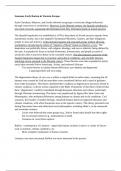Sussman, Early Racism in Western Europe.
Early Christians, Hebrews, and Greeks allowed out-groups to overcome alleged inferiority
through conversion or assimilation. However, in the fifteenth century, the Spanish introduced a
new form of racism, separating Old Christians from New Christians based on Jewish ancestry.
The Spanish Inquisition was established in 1478 to keep those of Jewish ancestry separate from
mainstream society, but it also targeted Christianized Muslims, Gypsies, and later indigenous
people in Asia and America. It discriminated against and separated groups without allowing
assimilation, introducing the notion of "impurity of blood" based on ethnicity or race. The
Inquisition was politically driven, with religion, ideology, and race or ethnicity being defined by
the state. It expanded its focus to include Protestants, homosexuals, and people accused of
witchcraft when it moved to Rome in the sixteenth century. The discriminatory practices of the
Spanish Inquisition began due to economic and political conditions, and scientific theories
justifying racism emerged in the fifteenth century. These theories were later expanded to justify
racist ideas towards Native Americans, Asians, and enslaved Africans
- Two main theories to explain human differences: pre-adamite and degenerate
- Lingering beliefs still exist today
The degeneration theory of race was a widely accepted belief in earlier times, assuming that all
humans were created by God but nonwhites were considered inferior and in need of guidance
from white Europeans. This theory attributed their condition to degenerative processes related to
climate, isolation, or divine action explained in the Bible. Proponents of this theory believed that
these "degenerates" could be remediated through European education and culture, particularly
through Christian missionizing. The theory was popularized by figures like John Locke and
Montesquieu, who attributed differences among humans to climate and social conditions. Carl
Linnaeus, the founder of modern biology, classified humans based on supposed education and
climatic situations, with white Europeans seen as the superior variety. This theory persisted even
during Darwinian times and influenced racial philosophies, including Hitler's, in the nineteenth
and twentieth centuries
- Locke even believed that some groups (e.g., Native Americans) should lose their rights
due to personal failures (e.g., maltreatment of land)
- Linnaeus est. term Homo sapiens
Buffon - contemporary of Linnaeus - argues that human variation is due to a variety of factors
such as nutrition, climate, epidemics, etc.
- More complete explanation of human variation
Linnaeus was more structured; Buffon was more interested in the process
,1775 - Blumenback published natural variety of mankind - specified five varieties of humans
(caucasian, mongoloid, ethiopian, american, malay)
Lamarck - created many theories of evolution
- Environment changes needs of organisms which changes behavior
- Criticized - too radical
The Pre-Adamite or polygenic theory of human variation existed alongside the degenerate theory
from the sixteenth century to Darwin's times. It challenged the traditional view of a single
creation of man and proposed that people in faraway places were from a different source, not
descended from the same progenitor as the rest of the human world
Isaac La Peyrere's pre-Adamite theory was the most influential in racist ideology during this
period. It suggested that there were multiple creations of humans, with different races having
separate origins
The polygenic theory was not as popular as the degeneration theory, which adhered more closely
to the biblical account of human origins. However, it still had a minority following, including
notable figures like David Hume, who advocated for the separate creation and innate inferiority
of nonwhite peoples .
The polygenic theory of race persisted and influenced racial philosophies in the nineteenth and
twentieth centuries, including during Darwinian times
Immanuel Kant - very influential philosopher during Enlightenment who created racism
anthropology based on skin color
- Classified humans based on color and climate
- Also argued that races differentiated by degree of innate talent
- Non-whites = sub-persons
Louis Agassiz, a prominent scientist, supported the idea of innate racial inferiority. He declared
his support for the polygenic position that people of African descent were inferior to Europeans.
Agassiz's views were influential and served as a defense against Darwinism.
- Every race is created differently w/ different talents
"Types of Mankind," a textbook published in 1854, was a significant book that set the issue of
race in a scientific context for the general public. It used scientific data to justify the institution
of slavery and promoted the idea of racial superiority and the dangers of racial mixing.
Gobineau - grandfather of modern academic racism. Influenced racial purity
,Lecture 1 - 9/5
, Sociological perspective
- Sociology - systemic study of human behavior, social interactions, social institutions,
society
- Mills on sociological imagination (perspective) - vivid awareness of relationship between
personal experience and wider society
- Looks at historical legacies, context (in flux), social/political/economic structures
Terms
- Racial group - physical differences
- Ethnic group - based on cultural differences (language, dressing, food habits)
- Meanings are fluid and contingent on history & context (society defines these terms and
gives it significance)
Paradigms
- Functionalism - society is composed of interrelated parts that work together to maintain
stability w/in society; stability is threatened by dysfunctional acts & institutions
- Racial oppression & systemic discrimination - dysfunctional acts - but serve positive
function from perspective of racists
- Racist beliefs, racial ideologies, and myths support maintenance of unequal social
structures
- Conflict theory - society is characterized by social inequality; social life is struggle for
scarce resources; social arrangements benefit some groups at expense of others
- Labeling theory - society is sum of interactions of people & groups; self identity &
behavior of individuals may be determined or influenced by how society
describes/classifies them; labeling is associated w/ concepts of stereotyping and self
fulfilling prophecy
Lecture 2 - 9/7




